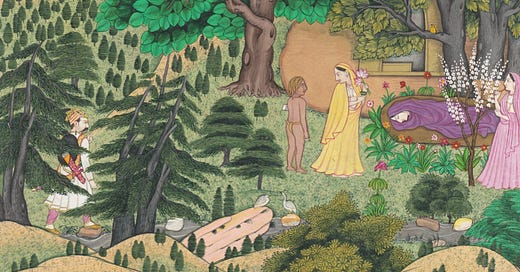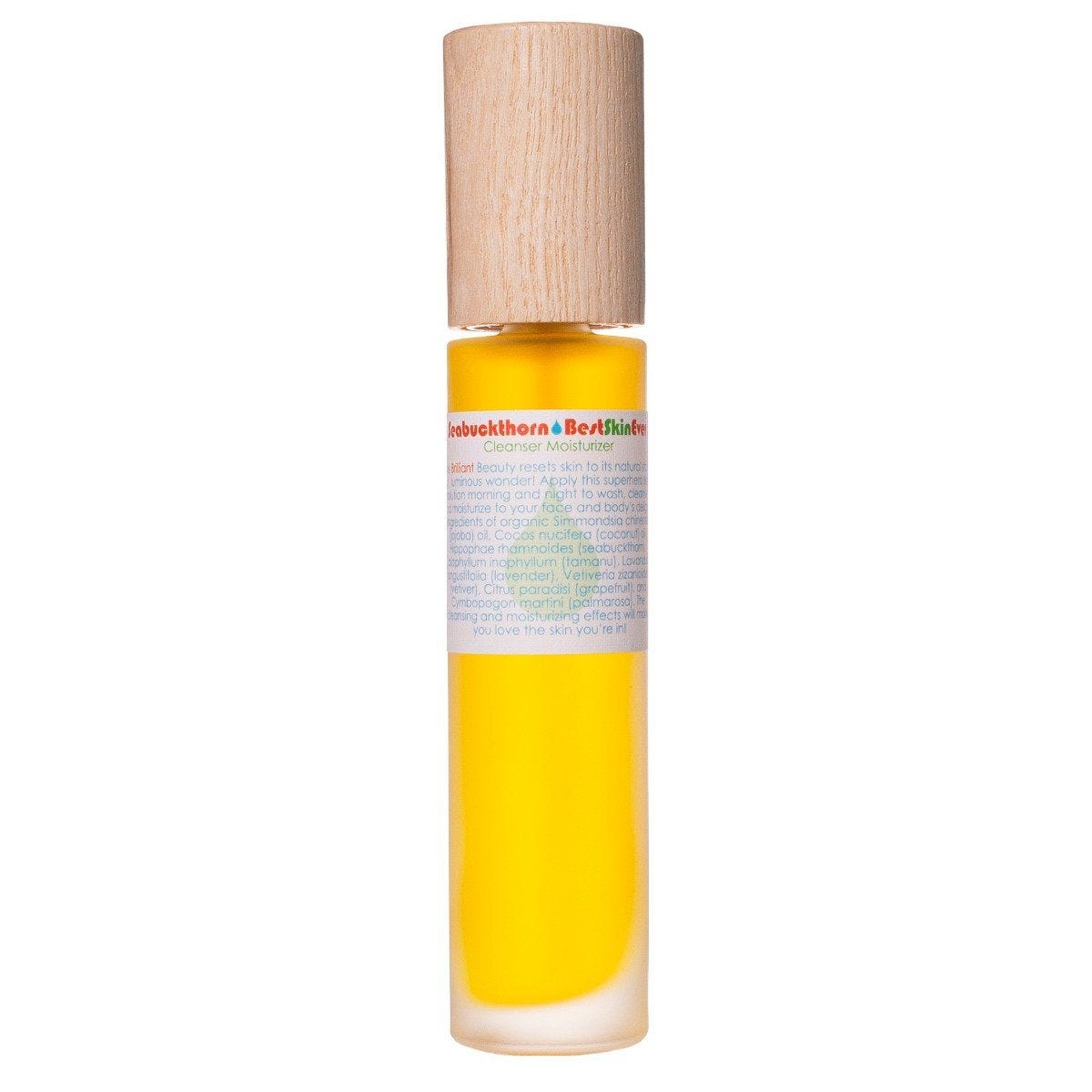Beauty is a Synonym for Wellbeing
10 Wellness Hacks I Learned from the Creator of Living Libations

I love Nadine Artemis’ writing because she writes kooky-sounding things like “I invite you on a joyful journey of cellular rejuvenation” and “the vagina is, in fact, a gateway and passage to the brain.” But the closer one reads, the clearer it becomes that Queen Nadine is not fruity at all, but an incredibly sincere source of time-honored knowledge. You might have heard of Nadine or her company Living Libations; both are perhaps best known on the internet for formulating a banger of a skincare oil that looks like this:
But Nadine’s book, Renegade Beauty, flies way under the radar. Though the word beauty is in the title, the book understands the word beauty as a symptom of whole-body wellbeing. Its pages are chock-full of practical advice, tips, and recipes for looking good from the inside out. “Beauty from the inside out” has become a bit of a marketing cliche over the years, but perhaps that’s because a speckle of something true resides in that ideal: that beauty is not something to be bought or sold, but something we all, democratically, have the power to cultivate.
To that end, here are ten things I learned while reading Nadine’s wellness bible:
1. Teeth are everything: Everyone talks about the gut microbiome; far fewer, in my estimation, are invested in the mouth microbiome. Did you know there are more bacteria in your mouth than there are people on the planet? Nadine taught me that oral health is overall health. Our teeth are connected, via our bloodstream, to every gland and organ in our body. And because the rate of absorption in our mouths is so high — the tissue of the skin wall, the epithelium, is only one cell thick —what we put into our mouths really matters.
She recommends several quick, easy ways to level up your dental routine. Here’s one: if you want brighter teeth without doing damage to the microbiome, mix 1/2 teaspoon of 3% food-grade hydrogen peroxide with 1 teaspoon of baking soda and brush with a dry electric toothbrush.
Another favorite is adding essential oils (of any of the following: thyme, peppermint, cardamom, tea tree, clove, or cinnamon) to your floss. The aforementioned oils are known for balancing mouth bacteria without carpet-bombing your mouth with chemicals.
Speaking of essential oils…
2. What essential oils are really good for: I’ve been a long skeptic of essential oils. What are they really good for beyond a nice whiff of lavender and propping up MLMs? But Nadine makes a compelling case for essential oils. They are chock-full of terpenes, medicinal compounds produced by many plants (mostly conifers) that help the liver break down carcinogens, stimulate cell death in abnormal cells, and reduce inflammation. Oils rich in terpenes include frankincense, grapefruit, cypress, orange, lemon, laurel, and rose otto. You can also level up your dry brushing routine by applying a couple drops of essential oil on the bristles before moving the brush in small circular motions upwards and toward your heart.
3. You can use sandalwood oil as a natural deodorant. This is a game changer for me. I grew up visiting my mother’s home country of India, where sandalwood trees grow naturally. Family members gifted me pens made of sandalwood and once, a handheld fan comprised of thin sheets of the fragrant wood. For so long the scent was solely a reminder of India until Nadine turned me onto sandalwood oil as a chemical-free antiperspirant: it contains phytoandrogens, which when met with the natural androgens of our armpit become a “pheromone perfumery.”
4. Where to find spring water near you. Tap water is often rife with fluoride, chlorine, et cetera: the Associated Press investigated the amount of pharmaceutical drugs found in US tapster and found traces of drugs in 24 metropolitan areas.
5. Cheap & brightening manicure = sea salt + baking soda + lemon + tea tree oil. This one’s pretty straightforward: In a bowl, combine 5 ml sea salt, 5 ml baking soda, 60 ml warm water, 5 drops of lemon, 3 drops of tea tree oil. Soak hands for 10 minutes, then scrub nails clean. Moisturize.
6. Why Earl Grey tea is supreme: Bergamot oil is derived from a tree called citrus bergamia, which blooms in the Italian winter. This essence is known for soothing anxiety and balancing the brain’s hypothalamus, so much so that Paoli Rovesti at the University of Milan studied its effects on human psychology and concluded that it is “the most valuable oil at the aromatherapist’s disposal.” He also suggested bergamot for those trying to quit nicotine, as it lowers stress and nervousness.
7. ACV as a hair rinse and more: Apple cider vinegar is well-known as a blood-sugar balancer & a useful ingredient to draw mineral out of broth. But — when diluted by 50% (and only when) — it’s an excellent topical for first aid, skincare, and haircare. It’s great in baths, can minimize milia (those tiny, hard white pearls that appear beneath the skin), and as a hair rinse for super shiny, dandruff-free hair.
8. The real culprit behind sun damage to the skin: this is one of Nadine’s hotter takes. Her argument is that our modern, industrial diet of ultra processed omega-6 polyunsaturated and trans fats and ungodly levels of corn syrup is the real culprit of aging and wrinkles, not the sun. She references a study conducted by the Research Foundation for Plastic Surgery in Los Angeles. The study surveyed premature aging in 1,000 women and found that women who ate polyunsaturated and trans fats showed 78% more signs of facial premature aging, some appearing more than 20 years older than their age.
9. An app that tracks the sun and tells you where and when you can get vitamin D. It’s called D Minder. It calculates your geographic location, current cloud cover, and time of year to let you know how long to bask in the sun and how much vitamin D will be generated that day. We’re almost out of the winter cave but I will still be using this until we get to summer.
10. What hurricanes, spiderwebs, pineapples, and our bodies have in common: They tell us something about beauty and symmetry. Leonardo Fibonacci was a monk in the 13th century who became famous for noticing a pattern that repeats in nature. This pattern led to the golden ratio (1.618), also known as phi. Our eyes, for some mystical reason, find this ratio exceedingly pleasing. And it is at work within and without us: a honeybee’s reproductive colony’s patters follow the Fibonacci sequence. The ratio of a human forearm to a human hand is phi. A DNA molecule’s double helix is 34 angstroms x 21 angstroms, the ratio of which is 1.6190476. Our faces, even: the size of our mouths, the length of our noses, the position of our eyes: these hover around the same ratio. We are all models of mathematical beauty. ✦˚*
Thank you for reading East/West. I’d love to know how you use everyday pantry, home, or garden objects, as well as if a material from your childhood has resurfaced in your wellbeing routine in an unexpected way. I’d love to hear from you in the comments.








This was such a lush and fascinating read, equal parts poetic and practical. I’ve always been drawn to rituals that feel rooted in both the body and memory, so I loved the mention of sandalwood, ACV baths, and even bergamot (Earl Grey tea is my forever comfort drink). It made me think about how scent and texture shape our well-being without us even realizing. Thank you for sharing these, my Amazon cart and curiosity are now both very full.